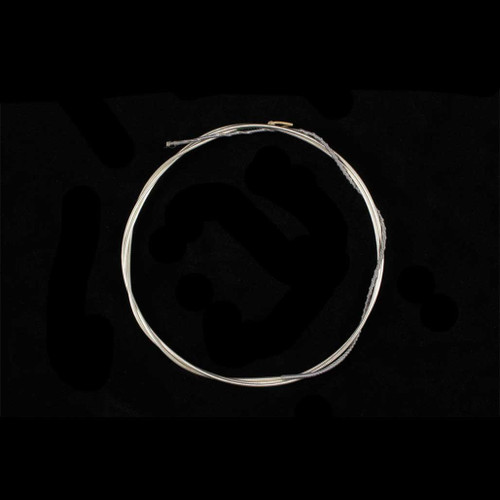Description
Gamut Academie strings are designed for Baroque instruments by those musicians playing historical performance practice at a=415, and are perfectly suitable for modern a=440 practice, but the result will be a little bit more tension at a=440.
This is a single-length (48", 120cm) beef serosa string intended for “Equal Tension” performance practice with a sterling silver wire wound onto the gut in tandem with a thin silk layer wound onto the core between the gut and wire. Because the wire is round, the surface of the wire is polished so that the string has a smooth, “half-wound” feel. The tone is warm and full.
Cello C-4 Gut/Silver-Wound wire and stocking lengths:
- Knot to stocking - 35.75" (90.5cm)
- Stocking length - 8.5" (22cm)
- Total string length - 44.25" (112cm)
If your instrument requires additional wire or stocking length, please contact us: support@gamutmusic.com.
The end of the string that goes into the tailpiece is knotted and there is a loop of gut on the end. This knot will hold the string in most historical tailpieces, but will slip through a modern tailpiece. Modern tailpieces have a hole-and-slot arrangement for holding the string in place and most tailpieces today have slots cut into them that are so wide that the knot tied at the end of the gut string will slip through when tension is put on the string. To prevent this, we can install a leather washer on the string before it is wound. This washer is wide enough that it will prevent string ends from slipping through most tailpiece slots. There is an extra charge for this service.
Custom Gauged equal tension strings are gauged with the equivalent-gauge system. This means that the gauge listed, such as =1.50mm, indicates that the string is approximately equal in weight to a plain gut string of that diameter. Of course, because the silver wire is so much heavier than gut, the string will be much thinner than a gut string.
A new option now available for the Academie line of wound strings involving the silk underlayer. This is a thin wrapping of silk that is wound around the core of the string before the wire is wound on. For many years we have been putting this underlayer on Academie strings in response to customer requests, but awareness and knowledge of historical performance practice has progressed enough now that we can offer this feature as an option. According to our research, it is unlikely that such an underlayer would have been used on wound music strings before about 1900 — and for those players who want to explore the true nature of historical strings, we are now offering to make strings without this buffer layer. The effect of the underlayer is to increase the internal damping in the string which gives the string a warmer tone. Without the underlayer, the tone of the string is brighter and has more of the lush, ravishing tone attributed to historical times.
Equal Tension is a concept that was used on violins historically. The idea is that each string has the same amount of tension, resulting in equal tension on all strings. The customary way to tension strings is to decrease the tension from the top string, which has the most tension, to the bottom string in decreasing amounts on each string. From the 16th to 19th centuries there are writers who mention or recommend equal tension, and this seems to have been one aesthetic that some players used. Merssene, in the early 1600s, mentioned that violin strings should have equal tension, but that in practice most players used less tension on the lower strings. It may be that the idea of “equal” was an intellectual concept of perfection and that, in practice, players found that lowering the tension on the thicker bottom strings was just more practical. Regardless of the extent of the historical use, many modern players find that this system of string allows a quicker and louder response from the instrument. The extra tension on the lower strings allows the bow to play more on top of the strings resulting in quicker bowing.
Because of the added diameter on equal tension strings, your instrument may need some adjustment at the tailpiece, bridge or nut to allow for the extra mass of the strings. The instrument may also need sound post or other adjustments to bring out the most responsive tone.
#
Hand-made in the USA by Gamut Music, Inc., a leader in the revival of early music strings and instruments. Gut strings are not intended to be used with fine tuners or string adjusters, and those devices should be removed before installing the gut string on the instrument.
All Gamut Academie strings (pure gut and gut/metal-wound) are made with beef serosa unless they specifically say "Sheep Gut." All pure gut Tricolore violin and viola strings are made with sheep gut; gut/metal-wound Tricolore and all Red Diamond strings are made with beef serosa.
Gamut gut string gauges are approximate (≈) diameter. Meaning, that while a ≈0.60mm string is polished in the workshop to a diameter of 0.60mm, changes in ambient humidity, temperature, shipping, and storage conditions can cause to string to expand or contract slightly.
Gimped gut strings and custom gauged equal tension strings are gauged with the equivalent-gauge (=) system. This means that the gauge listed, such as =1.50mm, indicates that the string is approximately equal in weight to a plain gut string of that diameter. Of course, because the wire is much heavier than gut, the string will be much thinner than a plain gut string.
More information about Gamut gut strings, string types, gauges, and string tensions can be found on our FAQ/Articles page. Not finding an answer to your question? Please contact us directly: support@gamutmusic.com.


